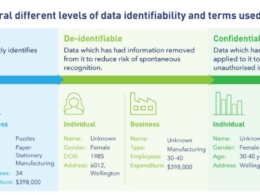Companies that succeed at data sharing get more value from analytics initiatives — and chief data officers who facilitate sharing play a more strategic business role
MIT Sloan Management Review
Brian Eastwood
Sep 9, 2021
For decades, business leaders have shied away from sharing data — not just with competitors, but even with internal stakeholders in other business units.
This mindset is starting to shift, however, as studies back up the benefits of sharing data.
According to the latest Gartner Chief Data Officer Survey, data sharing is a business-facing key performance indicator of
- achieving effective stakeholder engagement and
- providing enterprise value.
CDOs who have successfully executed data-sharing initiatives in their organizations are 1.7 times more effective at showing business value and return on investment from their data analytics strategy.
These leaders also see their roles mature beyond data and analytics to engage in digital transformation and overall business strategy.
“When you share data and you’re able to generate more robust analytics and … demonstrate and drive more value, you have more involvement and potentially more influence,” said Lydia Clougherty Jones, senior research director in Gartner’s Data and Analytics Group.
“Data plays an enormous role in driving better relationships with employees and better relationships with the customers.”
CDOs who have successfully executed data-sharing initiatives in their organizations are 1.7 times more effective at showing business value and return on investment from their data analytics strategy.
At this summer’s MIT Chief Data Officer and Information Quality Symposium ( MIT CDOIQ), Clougherty Jones discussed why the benefits of data sharing now outweigh the risks and explored how CDOs can overcome entrenched resistance to data sharing.
Tie data sharing initiatives to companywide goals
There used to be good reasons for companies to establish data siloes.
“A lot of information was proprietary and related to valuable intellectual property. It made sense to not disclose it unless there was a reason to,” Clougherty Jones said.
“But if you think about modern day data, we’re not in that world anymore.”
Companies now realize not all data should be treated the same, relying on sophisticated methods of protecting some information while making other data sources readily available to those with the right to access it.
There used to be good reasons for companies to establish data siloes. … But if you think about modern day data, we’re not in that world anymore.”
The most successful CDOs can tie data sharing initiatives not just to information technology goals but to companywide KPIs such as
- improved customer experience,
- cost optimization,
- revenue generation,
- or compliance.
In addition, leaders who achieve these types of results are increasingly asked to
- take on digital transformation efforts and
- other strategic objectives,
Clougherty Jones said. In other words, their focus is moving from data and analytics in IT alone to data and analytics for the business as a whole. These CDOs were also more likely to see their budgets increase.
There’s a clear tie between achieving value from data and analytics and seeing value from digital transformation.
“It’s crucial to start talking about data and digital not synonymously but in tandem, because they both can drive measurable value to your organization,” she said.
Talk about data sharing to overcome roadblocks
- Given these findings, Gartner predicts that organizations that promote data sharing will outperform their peers on most business value metrics as soon as 2023.
- At the same time, the firm suggests that less than 5% of current corporate data sharing programs can identify and locate trusted data sources.
“We all know it’s difficult,” Clougherty Jones said. “Data management can be a roadblock if it’s too inflexible, if there are insufficient tools and technologies, or if there are regulatory prohibitions and security risks.”
Collaboration with the right amount of data sharing is not only good for industry but good for individual business, citizens, and consumers.
Lydia Clougherty Jones Senior Research Director, Gartner
Communication is a key component to overcoming resistance to data sharing.
Successful CDOs shift the narrative away from the risks of sharing to the risks of not sharing, Clougherty Jones said.
The impact could be small, such as equipment that fails due to a lack of access to diagnostic data, or large, such as a lost competitive advantage due to delayed decision-making.
“You target business outcomes,” she said. “Instead of thinking about data first, think about outcomes, then think about business relationships, then think about how data can drive those outcomes to enhance those relationships.”
For this discussion, it helps to bring in various perspectives, such as tactical versus strategic needs, regulatory compliance versus the impact on innovation, or data access versus data security.
Weighing conflicting perspectives makes it easier to identify the real risk of not sharing data, rather than basing a decision on a perceived risk, Clougherty Jones said.
Improving data literacy throughout the organization is another critical part of the CDO’s communication strategy.
“When everyone ‘speaks data’ in the same way, everybody can understand each other,” Clougherty Jones said.
The immediate benefit is giving employees the skills they need to make data-driven decisions, while the downstream effect is empowering employees to use data to monetize assets and drive value, she said.
If nothing else, CDOs can point to the growing use cases for data sharing, even among competitive organizations:
- Safety in aviation,
- efficiency in global supply chains,
- customer experience in retail,
- predictive analytics in health care,
- student life on college campuses, and so on.
“There’s now a recognition that collaboration with the right amount of data sharing is not only good for industry but good for individual business, citizens, and consumers,” Clougherty Jones said.
3 steps to building a data-sharing culture
CDOs may recognize the benefits of data sharing, but shifting from the status quo of data ownership cannot happen overnight. As organizations continue conversations among executives and business line managers, Clougherty Jones provided three recommendations for building a culture of data sharing:
- Set priorities
- Prepare the enterprise
- Educate legal counsel
Set priorities. Many CDOs say they’re overwhelmed with options for using data. Clougherty Jones tells them to prioritize three types of initiatives: internal cost savings, net new revenue or other outward-facing business value, or risk mitigation. In this case, she said, risk isn’t necessarily the misuse or loss of data; instead, it’s poor operational or financial decision-making due to a lack of data.
Prepare the enterprise. Breaking down data silos isn’t just a matter of integrating business applications and developing a data management strategy. CDOs need to address the “emotional barriers” around sharing data, she said. “There is a fear that if data is shared, there’ll be risk of harm, or risk of exposure, or [risk of] showing a lack of performance.” It helps to tie a push for sharing data to a specific business case or strategic goal with clearly defined KPIs.
Educate legal counsel. The more the legal team knows about data, the better, said Clougherty Jones, who has two decades of experience as a lawyer helping enterprises navigate data-sharing compliance. Helping to improve the legal department’s data literacy leads to better contracts, better risk protection, and better-defined business goals. “We have seen so many instances of missteps,” she said. “A contract could have provided for innovative data value generation — but nobody knew about it.”
Originally published at https://mitsloan.mit.edu on September 4, 2021.
TAGS: Data sharing; CDO;
Names mentioned:
Lydia Clougherty Jones, senior research director in Gartner’s Data and Analytics Group;












